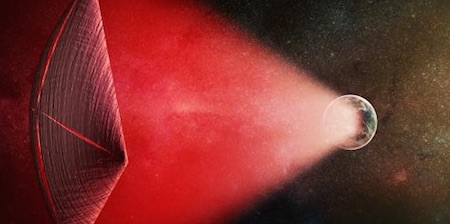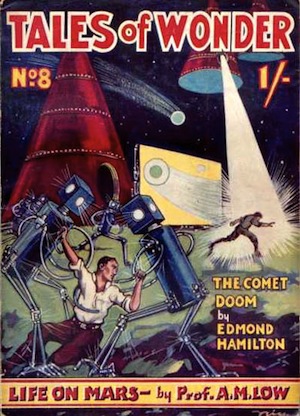Science Fiction
Dictionary
A B C D E F G H I J K L M N O P Q R S T U V W X Y Z
Are Observed Radio Bursts An Alien Propulsion Technology?

Harvard astrophysicists wonder if it could be worth examining a set of fast radio bursts to see if it could be evidence of an alien propulsion technology.

(Artist concept of alien sails and propulsion)
"Fast radio bursts are exceedingly bright given their short duration and origin at great distances, and we haven't identified a possible natural source with any confidence," said theorist Avi Loeb of the Harvard-Smithsonian Center for Astrophysics. "An artificial origin is worth contemplating and checking."As the name implies, fast radio bursts are millisecond-long flashes of radio emission. First discovered in 2007, fewer than two dozen have been detected by gigantic radio telescopes like the Parkes Observatory in Australia or the Arecibo Observatory in Puerto Rico. They are inferred to originate from distant galaxies, billions of light-years away.
Loeb and his co-author Manasvi Lingam (Harvard University) examined the feasibility of creating a radio transmitter strong enough for it to be detectable across such immense distances. They found that, if the transmitter were solar powered, the sunlight falling on an area of a planet twice the size of the Earth would be enough to generate the needed energy. Such a vast construction project is well beyond our technology, but within the realm of possibility according to the laws of physics.
Lingam and Loeb also considered whether such a transmitter would be viable from an engineering perspective, or whether the tremendous energies involved would melt any underlying structure. Again, they found that a water-cooled device twice the size of Earth could withstand the heat.
I don't know about alien civilizations, but on this planet this idea has a relatively brief history (with a surprising outlier). In a 1962 book by Dr. Robert Forward titled Report on Laser Design Study, we find "results of the design analysis indicate the feasibility of proceeding with the construction of a LASER cannon system at once." This idea was used creatively in the 1974 Niven/Pournelle classic Mote in God's Eye:
"Captain, look," he said, and threw a plot of the local stellar region on the screen. "The intruder came from here. Whoever launched it fired a laser cannon, or a set of laser cannon - probably a whole mess of them on asteroids, with mirrors to focus them - for about forty-five years, so the intruder would have a beam to travel on. The beam and the intruder both came straight in from the Mote.
See the entry for laser cannon from Niven and Pournelle's novel.
However, this is not the earliest instance of this idea. Golden Age science fiction great Edmond Hamilton wrote about ships propelled by light pressure in his 1929 story The Comet Doom.

(Light cones for light propulsion)
Via Harvard Center for Astrophysics.
Scroll down for more stories in the same category. (Story submitted 3/16/2017)
Follow this kind of news @Technovelgy.| Email | RSS | Blog It | Stumble | del.icio.us | Digg | Reddit |
Would
you like to contribute a story tip?
It's easy:
Get the URL of the story, and the related sf author, and add
it here.
Comment/Join discussion ( 0 )
Related News Stories - (" Space Tech ")
Will Space Stations Have Large Interior Spaces Again?
'They filed clumsily into the battleroom, like children in a swimming pool for the first time, clinging to the handholds along the side.' - Orson Scott Card, 1985.
Reflect Orbital Offers 'Sunlight on Demand' And Light Pollution
'I don't have to tell you about the seven two-mile-diameter orbital mirrors...'
Chrysalis Generation Ship to Alpha Centauri
'This was their world, their planet —
this swift-traveling, yet seemingly moveless vessel.' - Nat Schachner, 1934
The First Space Warship For Space Force
'Each of the electrical ships carried about twenty men...' - Garrett P. Serviss, 1898.
Technovelgy (that's tech-novel-gee!) is devoted to the creative science inventions and ideas of sf authors. Look for the Invention Category that interests you, the Glossary, the Invention Timeline, or see what's New.
Science Fiction
Timeline
1600-1899
1900-1939
1940's 1950's
1960's 1970's
1980's 1990's
2000's 2010's
Current News
Proof Of Robothood - Not A Person
'Who are you people? - Show 'em.'
Dancing Robots Taught Dance Moves
'A clockwork figure would be the thing for you...'
Indonesian Clans Battle
'The observation vehicle was of that peculiar variety used in conveying a large number of people across rough terrain.'
The 'Last Mile' In China Crowded With Delivery Robots
Yes, it's a delivery robot. On wheels.
Tornyol Microdrone Kills Mosquitoes
'The real border was defended by... a swarm of quasi-independent aerostats.'
PLATO Spacecraft, Hunter Of Habitable Planets, Now Ready
'I ... set my automatic astronomical instruments to searching for a habitable planet.'
Factory Humanoid Robots Built By Humanoid Robots
'...haven't you a section of the factory where only robot labor is employed?'
iPhone Air Fulfils Jobs' Promise From 2007 - A Giant Screen!
'... oblongs were all over the floor and surfaces.'
ChatGPT Now Participates in Group Chats
'...the city was their laboratory in human psychology.'
iPhone Pocket All Sold Out!
'A long, strong, slender net...'
Did The Yautja Have These First?
What a marvel of ingenuity the little device was!
Jetson ONE Air Races Begin, Can Air Polo Be Far Behind?
'If you're one of those rarities who haven't attended a rocket-polo "carnage", let me tell you it's a colorful affair.'
Will Space Stations Have Large Interior Spaces Again?
'They filed clumsily into the battleroom, like children in a swimming pool for the first time, clinging to the handholds along the side.'
Mornine Sales Robot
'Robot-salesmen were everywhere, gesturing...'
Bipedal Robot Floats Gently While Walking
'a walking balloon proceeded with long strides of its aluminum legs...'
Musk Idea Of Cars Talking To Each Other Predicted 70 Years Ago
'My cars talk to one another.'
